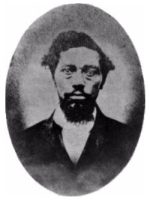ECW Weekender: Newby’s Crossroads
It is well-known where and how Dangerfield Newby’s life ended. But it is less known where his life began.

In the countryside of Rappahannock County, Virginia, Dangerfield Newby was born to a white father and enslaved mother around 1820. The young Dangerfield spent his youth as a slave, since slave children inherited the status of their mother. While living under his owner Henry Newby, Dangerfield worked as a blacksmith and on boats floating in a nearby canal.
At some point during his residence in this corner of Virginia, Dangerfield married a fellow slave who lived in the area named Harriett. Dangerfield and Harriett maintained their marriage despite being owned by two different people. They even began a family.
In 1858, Henry Newby moved his family and slaves to Ohio, where he freed his servants. Of course, in his enslaved situation, Dangerfield had no choice but to move away from his family. When he received his freedom, his family remained slaves in Virginia. Dangerfield did everything he could to purchase his family’s freedom. He raised over $700 in the attempt but pleading letters from Harriett forced his desperation. Seeking a quick solution, Newby joined John Brown and became the first of Brown’s raiders killed in the Harpers Ferry Raid.
Newby’s beginning was very different from his end. Enslaved, he might have faded unknown into history had fate not intervened. Now, perhaps Newby’s story is the best known of any of Brown’s followers.
His obscure beginnings become easily apparent on the drive to Newby’s Crossroads. It’s especially beautiful with the fall foliage. Many of you have trekked to Harpers Ferry where Newby’s story ended. Take a chance to see where his story began.

Newby’s Crossroads is at the intersection of Laurel Mills Road and Richmond Road near Amissville, Virginia. Three Civil War Trails signs stand at the intersection. One tells the story of Dangerfield Newby, the other relates Robert E. Lee’s travels through the county, and the last discusses a cavalry fight at the crossroads after the Battle of Gettysburg.

